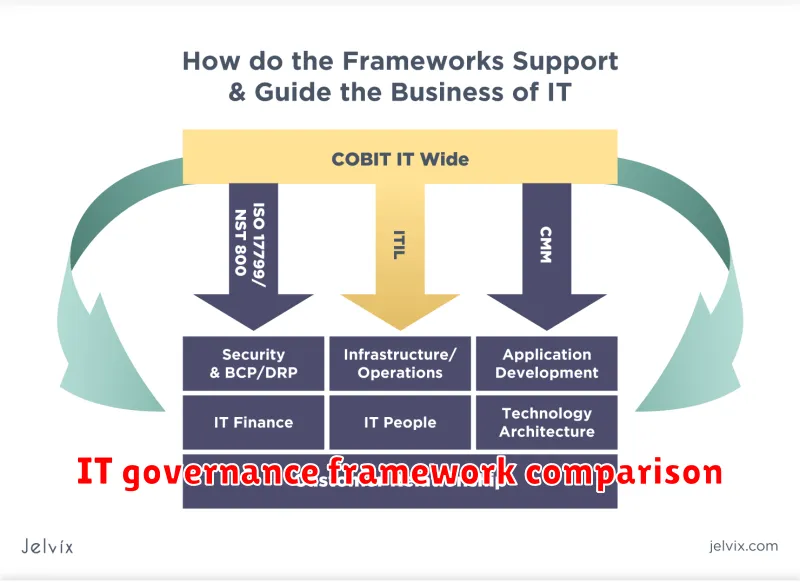In the rapidly evolving landscape of technology, organizations of all sizes are grappling with the challenge of managing their IT infrastructure effectively. IT governance, a critical component of this challenge, provides a structured framework for aligning IT with business objectives, ensuring security, compliance, and optimal performance. This guide explores some of the most widely recognized and adopted IT governance frameworks, including COBIT and ITIL, and delves into emerging trends and best practices for navigating the complexities of modern IT.
Whether you’re a CIO seeking to streamline operations, a security manager striving to strengthen defenses, or a business leader aiming to leverage technology for competitive advantage, understanding the principles and methodologies behind these frameworks is essential. From establishing clear policies and procedures to implementing robust risk management strategies, we’ll cover the key elements and practical applications that can help you achieve your IT governance goals.
Understanding IT Governance: Aligning IT with Business Objectives
In today’s digital age, information technology (IT) is no longer just a support function; it’s a strategic asset that drives business success. IT governance plays a crucial role in ensuring that IT investments are aligned with business objectives and that technology effectively supports organizational goals.
At its core, IT governance is the framework for managing and controlling IT resources to achieve business outcomes. It establishes clear responsibilities, accountability, and processes to ensure that IT investments deliver value and mitigate risks. Effective IT governance goes beyond simply managing technology; it’s about aligning IT with the overall business strategy.
Key benefits of strong IT governance include:
- Improved business alignment: IT investments are directly linked to business goals, leading to more impactful and efficient use of resources.
- Enhanced risk management: IT governance frameworks provide mechanisms to identify, assess, and mitigate IT risks, protecting the organization from potential threats.
- Increased efficiency and productivity: Streamlined IT processes and clear responsibilities boost operational efficiency, freeing up valuable resources for innovation and growth.
- Improved compliance and regulatory adherence: IT governance ensures that IT operations meet relevant legal and regulatory requirements, reducing the risk of penalties and reputational damage.
- Enhanced IT performance: By setting clear expectations, measuring performance, and fostering continuous improvement, IT governance helps optimize IT performance and deliver better value.
Key Principles of Effective IT Governance
IT governance is the framework that ensures IT supports the organization’s strategic goals. Its effectiveness depends on a set of key principles:
1. Alignment with Business Strategy: IT decisions and initiatives should be directly linked to the organization’s overall business strategy. This ensures that technology investments and initiatives contribute to achieving business objectives.
2. Risk Management: IT governance should identify and manage IT-related risks. It should have processes in place to assess, mitigate, and monitor risks, ensuring the organization’s IT infrastructure remains secure and reliable.
3. Value Creation: IT investments should generate tangible value for the organization. IT governance should monitor and evaluate IT initiatives to measure their impact on business performance and return on investment.
4. Transparency and Accountability: Clear roles, responsibilities, and accountability should be defined for IT governance. Transparency in decision-making and performance reporting fosters trust and confidence in IT operations.
5. Continuous Improvement: IT governance should be a dynamic process that adapts to evolving business needs and technological advancements. Regular review and improvement are essential to maintain effectiveness and achieve ongoing value creation.
By adhering to these key principles, organizations can establish robust IT governance frameworks that ensure their IT investments align with strategic goals, manage risks effectively, and deliver tangible business value.
Popular IT Governance Frameworks: COBIT, ITIL, ISO 27001, and NIST
IT governance frameworks are essential for organizations of all sizes to ensure that their IT investments are aligned with business goals. These frameworks provide a structured approach to managing IT risks, improving efficiency, and ensuring compliance with relevant regulations.
Here are four of the most popular IT governance frameworks:
COBIT
COBIT (Control Objectives for Information and related Technology) is a framework developed by ISACA (Information Systems Audit and Control Association) that provides a comprehensive set of guidelines for IT governance and management. It focuses on ensuring that IT resources are aligned with business objectives and that IT risks are effectively managed. COBIT is based on a five-component framework:
- Planning and Organization
- Acquisition and Implementation
- Delivery and Support
- Monitoring and Evaluation
- Governance and Management
ITIL
ITIL (Information Technology Infrastructure Library) is a set of best practices for IT service management. It provides a framework for aligning IT services with business needs and improving the effectiveness of IT operations. ITIL is divided into several core modules, including service strategy, service design, service transition, service operation, and continual service improvement.
ISO 27001
ISO 27001 is an international standard for information security management. It provides a framework for establishing, implementing, maintaining, and continually improving an information security management system (ISMS). ISO 27001 is particularly relevant for organizations that handle sensitive information, such as financial data, customer records, or intellectual property.
NIST
NIST (National Institute of Standards and Technology) is a US federal agency that develops standards and guidelines for a wide range of technologies, including IT. NIST offers several frameworks relevant to IT governance, including the NIST Cybersecurity Framework, which provides a risk-based approach to cybersecurity, and the NIST SP 800-53, which outlines security controls for federal information systems.
Choosing the right IT governance framework for your organization depends on your specific needs and requirements. Consider factors such as industry regulations, business objectives, and IT infrastructure when making your decision.
COBIT: Control Objectives for Information and Related Technologies
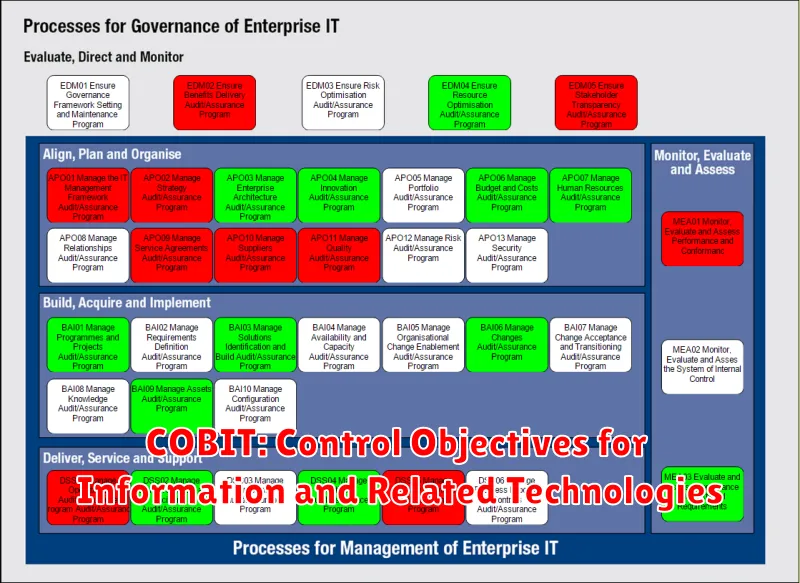
COBIT stands for Control Objectives for Information and Related Technologies. It is a widely recognized and internationally accepted framework for IT governance and management. COBIT provides a comprehensive set of guidelines, best practices, and principles for managing and governing enterprise IT, ensuring that it aligns with the organization’s overall business objectives.
The primary goal of COBIT is to help organizations achieve optimal value from their IT investments. It provides a framework for:
- Governance: Defining responsibilities, policies, and frameworks for IT decision-making.
- Management: Establishing processes, procedures, and controls for day-to-day IT operations.
- Risk Management: Identifying, assessing, and managing IT risks.
- Compliance: Meeting legal, regulatory, and industry standards.
COBIT is organized around five key principles:
- Meeting stakeholder needs: IT should support the organization’s goals and objectives.
- Covering the enterprise end-to-end: A holistic view of IT is essential.
- Applying a single integrated framework: A consistent approach to IT governance is crucial.
- Enabling a holistic approach: IT governance should encompass all aspects of IT.
- Separating governance from management: Distinct responsibilities for setting direction and executing operations are vital.
COBIT offers numerous benefits to organizations, including:
- Improved IT alignment with business goals: Ensuring that IT investments support the organization’s strategic objectives.
- Enhanced risk management: Identifying and mitigating potential IT risks effectively.
- Increased efficiency and effectiveness of IT operations: Optimizing IT processes and reducing inefficiencies.
- Improved compliance with regulatory requirements: Meeting legal and industry standards.
- Enhanced stakeholder confidence: Demonstrating responsible and effective IT management.
COBIT is a valuable tool for organizations of all sizes and industries. By implementing COBIT, businesses can gain a competitive advantage through improved IT governance and management practices.
ITIL: Information Technology Infrastructure Library
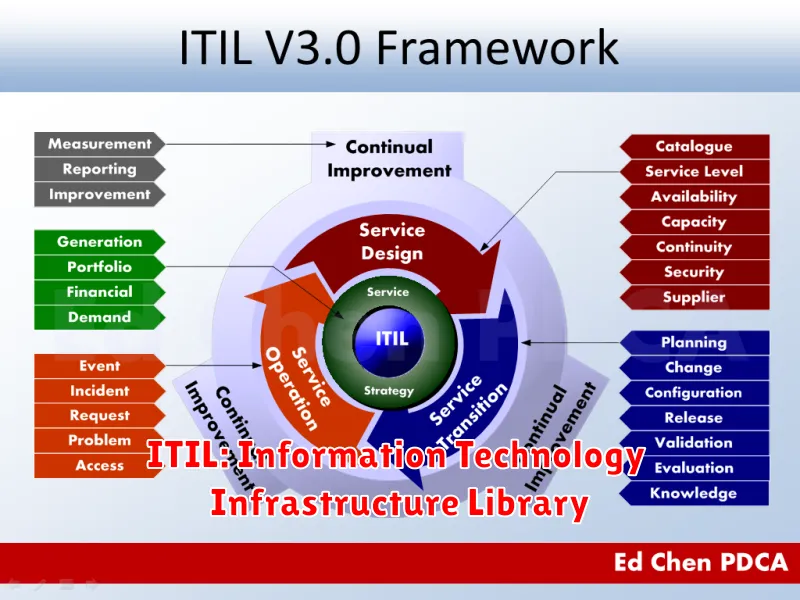
ITIL, or the Information Technology Infrastructure Library, is a widely recognized framework for IT service management (ITSM). It provides a set of best practices and processes for managing the entire lifecycle of IT services, from planning and design to delivery and support.
ITIL is a comprehensive framework that covers a broad range of ITSM areas, including:
- Service Strategy: Defines the overall IT service strategy, aligning IT with business needs.
- Service Design: Designs and plans IT services to meet business requirements.
- Service Transition: Manages the transition of new or changed services into production.
- Service Operation: Manages the day-to-day operation of IT services.
- Continual Service Improvement: Focuses on improving IT services and processes continuously.
ITIL has several benefits for organizations, including:
- Improved IT service quality: By following ITIL best practices, organizations can improve the quality and reliability of their IT services.
- Increased IT efficiency: ITIL helps streamline IT processes and reduce waste, leading to increased efficiency.
- Reduced IT costs: By optimizing IT operations, organizations can save money and reduce IT costs.
- Enhanced IT alignment with business: ITIL helps align IT services with business objectives, ensuring that IT effectively supports the organization’s goals.
ITIL is a valuable framework for organizations of all sizes. It provides a structured approach to IT service management, helping organizations deliver high-quality IT services that meet business needs.
ISO 27001: Information Security Management System
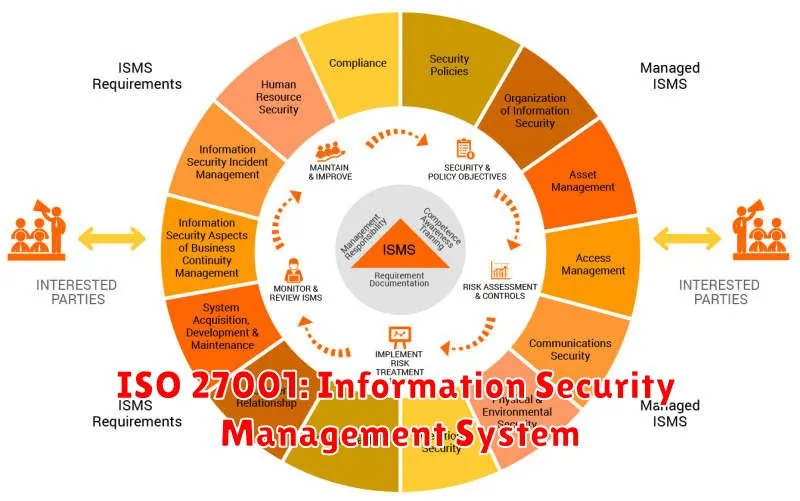
ISO 27001 is an internationally recognized standard for establishing, implementing, maintaining, and continuously improving an information security management system (ISMS). It outlines a comprehensive framework for managing sensitive information, protecting it from unauthorized access, use, disclosure, disruption, modification, or destruction.
Key Principles of ISO 27001
- Risk Management: ISO 27001 emphasizes identifying, assessing, and mitigating information security risks. This includes implementing appropriate safeguards and controls.
- Confidentiality, Integrity, and Availability: The standard focuses on maintaining the confidentiality, integrity, and availability of sensitive information. This ensures that information is kept secret, accurate, and accessible when needed.
- Continuous Improvement: ISO 27001 requires organizations to establish a process for continuous improvement of their ISMS. This involves regular reviews, updates, and enhancements to address changing threats and vulnerabilities.
Benefits of Implementing ISO 27001
- Enhanced Security: ISO 27001 helps organizations to strengthen their information security posture, reducing the risk of data breaches and other security incidents.
- Improved Compliance: The standard can assist organizations in meeting regulatory requirements and industry best practices related to information security.
- Increased Trust and Confidence: By demonstrating their commitment to information security, organizations can build trust with stakeholders, customers, and partners.
- Reduced Costs: Implementing ISO 27001 can help to reduce the cost of security incidents and improve operational efficiency.
Implementing ISO 27001
Implementing ISO 27001 involves a structured process that includes the following steps:
- Scope Definition: Determine the scope of the ISMS and the information assets to be protected.
- Risk Assessment: Identify, analyze, and evaluate information security risks.
- Policy Development: Establish information security policies and procedures.
- Control Implementation: Implement security controls to mitigate identified risks.
- Monitoring and Review: Monitor and review the ISMS regularly to ensure effectiveness and make necessary adjustments.
- Certification: Consider obtaining certification from an accredited body to demonstrate compliance with ISO 27001.
ISO 27001 is a crucial element of a comprehensive IT governance framework. By implementing this standard, organizations can effectively manage information security risks, protect sensitive data, and build trust with stakeholders.
NIST Cybersecurity Framework: A Risk-Based Approach
The National Institute of Standards and Technology (NIST) Cybersecurity Framework is a voluntary framework that provides a comprehensive set of activities to manage cybersecurity risk. It’s designed to be adaptable to organizations of all sizes and across various industries.
The framework is based on a risk management approach, which means it focuses on identifying, assessing, and mitigating potential threats to an organization’s cybersecurity. It’s divided into five core functions:
- Identify: This function involves understanding the organization’s assets, business processes, and the threats and vulnerabilities that could impact them.
- Protect: This function focuses on implementing safeguards to protect the organization’s assets from threats. This can include things like access control, data encryption, and security awareness training.
- Detect: This function is about putting in place measures to detect cybersecurity incidents as quickly as possible. This can include things like intrusion detection systems, security monitoring, and incident response planning.
- Respond: This function focuses on taking action to contain and mitigate the impact of a cybersecurity incident. This can include things like incident response procedures, data recovery, and communication with stakeholders.
- Recover: This function focuses on restoring the organization’s operations after a cybersecurity incident. This can include things like data recovery, system restoration, and business continuity planning.
The NIST Cybersecurity Framework is a valuable resource for organizations looking to improve their cybersecurity posture. It provides a clear roadmap for managing cybersecurity risk, and it can be adapted to meet the specific needs of any organization. By using a risk-based approach, the framework helps organizations to prioritize their security efforts and focus on the most important threats.
Benefits of Implementing IT Governance Frameworks
IT governance frameworks are essential for any organization that wants to ensure its IT investments are aligned with business objectives and that its IT operations are secure, efficient, and effective. Implementing these frameworks can provide a number of benefits, including:
Improved alignment of IT with business goals: IT governance frameworks help organizations define their IT goals and objectives and ensure that these are aligned with their overall business strategy. This helps ensure that IT investments are made in areas that will deliver the most value to the business.
Enhanced risk management: IT governance frameworks help organizations identify, assess, and manage IT risks. This can help reduce the likelihood of IT-related incidents and protect the organization from financial losses and reputational damage.
Increased efficiency and effectiveness: IT governance frameworks can help organizations streamline their IT processes and improve the efficiency of their IT operations. This can lead to cost savings and improved service delivery.
Improved compliance: IT governance frameworks can help organizations comply with relevant laws, regulations, and industry standards. This can help protect the organization from legal and financial penalties.
Enhanced transparency and accountability: IT governance frameworks can help organizations improve transparency and accountability in their IT operations. This can help build trust with stakeholders and improve the organization’s reputation.
Overall, implementing IT governance frameworks can provide a number of benefits that can help organizations improve their IT performance and achieve their business goals. These frameworks provide a structured approach to IT management, helping organizations to achieve greater control, efficiency, and effectiveness in their IT operations.
Choosing the Right Framework for Your Organization
Selecting the right IT governance framework is crucial for organizations of all sizes. A robust framework provides structure, direction, and accountability, ensuring your IT investments align with your business goals. This guide delves into popular frameworks like COBIT, ITIL, and beyond, helping you determine the best fit for your organization.
Consider the following factors when making your decision:
- Organization Size and Complexity: Larger, more complex organizations may benefit from comprehensive frameworks like COBIT, while smaller organizations might find ITIL’s focus on service management more suitable.
- Industry and Regulatory Requirements: Certain industries have specific compliance standards. For example, healthcare organizations might prioritize HIPAA compliance, which could influence their framework choice.
- Business Objectives and Goals: Align the framework with your specific business objectives. If you’re focused on risk management, COBIT’s robust risk assessment features might be ideal. Conversely, if service delivery is paramount, ITIL’s focus on service management might be more beneficial.
- Resource Availability: Implementation and ongoing management of frameworks require resources. Consider your team’s expertise, budget, and available time when evaluating different options.
Remember, no single framework is perfect for every organization. Carefully assess your needs and prioritize factors that align with your strategic goals. The right framework will provide a solid foundation for IT governance and empower your organization to achieve its objectives.
Key Steps in Implementing an IT Governance Framework
Implementing an IT governance framework is crucial for organizations seeking to effectively manage their IT resources and align them with business objectives. This process requires a systematic approach, encompassing multiple key steps. Here are some essential considerations for a successful implementation:
1. Define Clear Goals and Objectives: Establish a clear understanding of the desired outcomes of the IT governance framework. This may include improving IT alignment with business strategy, enhancing risk management, optimizing IT costs, or improving IT service delivery.
2. Select the Appropriate Framework: Choose a framework that aligns with the organization’s specific needs and goals. Popular options include COBIT, ITIL, and ISO/IEC 27001. Research different frameworks and compare their strengths and weaknesses to make an informed decision.
3. Establish a Governance Structure: Define the roles and responsibilities of key stakeholders involved in IT governance. Create a governance board or committee responsible for oversight, strategy, and decision-making.
4. Develop Policies and Procedures: Document clear policies and procedures for various aspects of IT governance, such as risk management, security, data privacy, and service delivery. Ensure these policies are understood and adhered to by all relevant parties.
5. Implement Risk Management Processes: Identify, assess, and mitigate risks associated with IT operations. Establish a comprehensive risk management framework that aligns with the organization’s overall risk appetite.
6. Implement Performance Measurement and Monitoring: Establish key performance indicators (KPIs) to track the effectiveness of the IT governance framework. Regularly monitor performance, identify areas for improvement, and adjust the framework as needed.
7. Continuously Review and Improve: IT governance is an ongoing process. Conduct regular reviews to ensure the framework remains relevant and effective. Make adjustments based on evolving business needs, technology advancements, and regulatory changes.
Establishing Clear Roles and Responsibilities for IT Governance
Effective IT governance requires a clear understanding of roles and responsibilities. This ensures everyone is aligned on expectations and accountable for their actions. A well-defined framework clarifies who is responsible for what, preventing duplication of effort and fostering collaboration.
Key Roles in IT Governance:
- Board of Directors: Oversees the strategic direction and risk management of IT, ensuring alignment with business objectives.
- IT Steering Committee: Provides guidance and oversight to IT management, ensuring the alignment of IT with business needs and priorities.
- IT Management: Responsible for the day-to-day operations and management of IT, including resource allocation, budget, and performance monitoring.
- Business Stakeholders: Represent different business units and provide input on IT needs and priorities.
Key Responsibilities:
- Strategy: Developing and aligning IT strategy with business objectives.
- Risk Management: Identifying, assessing, and mitigating IT risks.
- Performance: Measuring and reporting on IT performance against established metrics.
- Compliance: Ensuring compliance with relevant laws, regulations, and industry standards.
- Resource Allocation: Managing IT resources, including budget and personnel.
Best Practices for Establishing Roles and Responsibilities:
- Document Roles and Responsibilities: Create a clear and concise document that outlines the roles and responsibilities of each stakeholder.
- Define Accountability: Clearly define who is accountable for each specific task or area.
- Regularly Review: Periodically review and update roles and responsibilities to reflect changes in the business and IT landscape.
By establishing clear roles and responsibilities, organizations can improve communication, coordination, and accountability within their IT governance framework, leading to greater efficiency, effectiveness, and alignment with business objectives.
Measuring the Success of IT Governance Initiatives
Implementing IT governance frameworks like COBIT, ITIL, or others can significantly improve your organization’s IT operations. However, simply putting a framework in place isn’t enough. Measuring its success is crucial to ensure you’re achieving the desired outcomes and maximizing its benefits.
Key Success Metrics:
- Alignment with Business Objectives: Track how well IT governance initiatives support the organization’s strategic goals.
- Risk Management Effectiveness: Evaluate the framework’s ability to identify, assess, and mitigate IT-related risks.
- Compliance and Regulatory Adherence: Monitor adherence to relevant regulations and industry standards.
- Cost Optimization: Analyze the cost effectiveness of IT operations and resource utilization.
- Service Quality and Performance: Track key performance indicators (KPIs) related to service quality, reliability, and uptime.
- Employee Satisfaction and Engagement: Measure the impact of IT governance on employee morale and productivity.
Effective Measurement Techniques:
- Surveys and Feedback: Collect feedback from stakeholders on the effectiveness of the framework.
- Data Analysis: Use performance metrics, financial data, and risk assessments to evaluate progress.
- Audits and Reviews: Conduct regular audits to assess compliance and identify areas for improvement.
- Benchmarking: Compare your organization’s performance to industry best practices.
Continuous Improvement:
Measuring success is an ongoing process. Regularly analyze results, identify areas for improvement, and make adjustments to your IT governance framework to maximize its effectiveness. By continuously adapting and optimizing, you can ensure that your initiatives truly contribute to your organization’s success.
Common Challenges in IT Governance Implementation and How to Overcome Them
Implementing a robust IT governance framework is crucial for any organization looking to maximize the value of its IT investments and align IT with business goals. However, the path to successful IT governance implementation is not without its challenges. In this article, we’ll delve into some of the most common obstacles organizations face and provide actionable insights on how to overcome them.
1. Resistance to Change: One of the biggest hurdles is often the resistance to change from employees and stakeholders. Introducing new processes, policies, and tools can feel disruptive and unfamiliar.
Solution: Effective communication is key. Clearly explain the benefits of IT governance, address concerns, and involve stakeholders in the process. Start with pilot projects to demonstrate the value and gradually implement changes across the organization.
2. Lack of Executive Buy-in: Without strong support from the top, IT governance efforts can flounder. Leaders must champion the initiative and allocate necessary resources.
Solution: Clearly articulate the business case for IT governance. Highlight how it can contribute to achieving strategic goals, improve decision-making, and enhance risk management.
3. Lack of Clear Ownership: Vague responsibilities and unclear roles can lead to confusion and inefficiency. It’s essential to assign ownership for specific IT governance tasks and processes.
Solution: Establish a clear governance structure with well-defined roles and responsibilities. This might include an IT Steering Committee, IT Governance Board, or other relevant groups.
4. Inadequate Resources: IT governance requires time, expertise, and resources. Without sufficient investment, implementation can be challenging.
Solution: Prioritize IT governance initiatives and allocate resources accordingly. Consider leveraging existing skills within the organization and exploring external support options if needed.
5. Difficulty Measuring Success: It can be difficult to quantify the benefits of IT governance.
Solution: Establish clear metrics to track progress and measure the impact of IT governance initiatives. This might include key performance indicators (KPIs) related to cost optimization, risk mitigation, or service quality.
The Future of IT Governance: Trends and Predictions
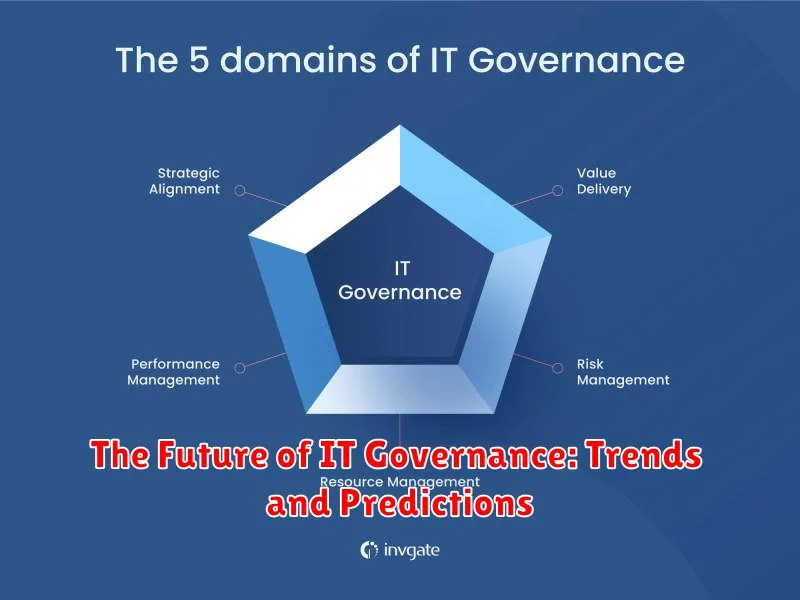
As technology continues to evolve at an unprecedented pace, the landscape of IT governance is also rapidly changing. Organizations are facing increasing pressure to adapt to new technologies, manage complex data, and ensure the security of their digital assets. In this dynamic environment, it is crucial to understand the key trends and predictions that will shape the future of IT governance.
One of the most prominent trends is the growing importance of cloud computing. As organizations increasingly rely on cloud services, IT governance frameworks need to adapt to the unique challenges and opportunities presented by this technology. This includes managing security, compliance, and data sovereignty in a distributed environment.
Another significant trend is the emergence of artificial intelligence (AI) and machine learning (ML). These technologies are transforming businesses in countless ways, but they also raise new governance challenges. Organizations need to develop frameworks for managing AI/ML risk, ensuring ethical use, and ensuring transparency in decision-making processes.
Furthermore, cybersecurity is becoming increasingly critical. As cyber threats become more sophisticated, organizations need to strengthen their security posture and implement robust governance frameworks to mitigate risks. This includes developing effective incident response plans, ensuring data privacy, and managing vulnerabilities.
Looking ahead, the future of IT governance will be characterized by a greater emphasis on agility, innovation, and risk management. Organizations will need to adopt a more flexible and adaptive approach to governance, embracing new technologies and embracing a culture of continuous improvement. They will also need to focus on building a robust risk management framework that can effectively address emerging threats.
In conclusion, the future of IT governance is both exciting and challenging. Organizations that embrace the key trends and predictions discussed above will be well-positioned to leverage technology for competitive advantage while mitigating risks and ensuring long-term success.

